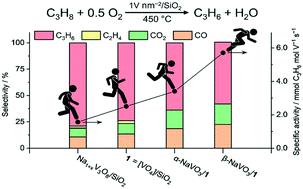当前位置:
X-MOL 学术
›
Catal. Sci. Technol.
›
论文详情
Our official English website, www.x-mol.net, welcomes your feedback! (Note: you will need to create a separate account there.)
Oxidative dehydrogenation of propane on silica-supported vanadyl sites promoted with sodium metavanadate
Catalysis Science & Technology ( IF 5 ) Pub Date : 2020-09-07 , DOI: 10.1039/d0cy01234c Manouchehr Nadjafi 1, 2, 3, 4 , Agnieszka M. Kierzkowska 1, 2, 3, 4 , Paula M. Abdala 1, 2, 3, 4 , Rene Verel 2, 4, 5, 6 , Olga V. Safonova 4, 7, 8 , Alexey Fedorov 1, 2, 3, 4 , Christoph R. Müller 1, 2, 3, 4
Catalysis Science & Technology ( IF 5 ) Pub Date : 2020-09-07 , DOI: 10.1039/d0cy01234c Manouchehr Nadjafi 1, 2, 3, 4 , Agnieszka M. Kierzkowska 1, 2, 3, 4 , Paula M. Abdala 1, 2, 3, 4 , Rene Verel 2, 4, 5, 6 , Olga V. Safonova 4, 7, 8 , Alexey Fedorov 1, 2, 3, 4 , Christoph R. Müller 1, 2, 3, 4
Affiliation

|
The promotion of silica-supported vanadyl species [VO4]/SiO2 (1) by α-NaVO3 or β-NaVO3 enhances the specific rate of the propene formation in oxidative dehydrogenation of propane (ODP) by, respectively, 30 and 125% at 450 °C and ca. 1 V nm−2 nominal coverage. The increased rate of propene formation is offset only moderately by a decreased selectivity to propene, which declines by 10 and 15% relative to 1 (74%) in α-NaVO3/1 and β-NaVO3/1, at 5.8 and 8.2% propane conversion. The structural characterization of the promoted catalysts by Raman mapping, X-ray absorption near edge structure (XANES), transmission electron microscopy (TEM) and solid-state nuclear magnetic resonance (51V and 23Na MAS NMR) allowed for associating the higher specific activity of β-NaVO3/1 with a higher dispersion of vanadium sites on the silica support, while the agglomeration of these sites with the concomitant formation of a poorly dispersed Na1+xV3O8 phase is related to a decreased catalytic activity. Surprisingly, solid-state 51V NMR and Raman spectroscopies reveal that the α-NaVO3/1 and β-NaVO3/1 catalysts contain the metastable β-NaVO3 phase, explained by a more favorable interaction of Na1+xV3O8/SiO2, formed after calcination in both materials, with β-NaVO3 than with α-NaVO3.
中文翻译:

偏钒酸钠促进的二氧化硅负载的钒基位上丙烷的氧化脱氢
促进二氧化硅负载氧钒物种的[VO 4 ] /的SiO 2(1)由α-NAVO 3或β-NAVO 3个增强了丙烷(ODP)的氧化脱氢的丙烯形成的特定速率被分别30和在450°C时约为125%1 V nm -2标称覆盖率。的丙烯形成的速率增加偏移仅适度通过选择性降低到丙烯,其通过相对于10和15%的下降1(74%)的α-NAVO 3 / 1和β-NAVO 3 / 1,丙烷转化率分别为5.8%和8.2%。通过拉曼作图,近边缘结构的X射线吸收(XANES),透射电子显微镜(TEM)和固态核磁共振(51 V和23 Na MAS NMR)对助催化剂的结构进行表征,从而可以关联更高的比的活性β-NAVO 3 / 1与在二氧化硅载体上的钒位点的较高的分散体,而这些位点的与伴随形成分散不良的Na的团聚1+ X V 3 ö 8相涉及一种降低的催化活性。令人惊讶的是,固态51V NMR和拉曼光谱揭示出α-NAVO 3 / 1和β-NAVO 3 / 1催化剂含有亚稳态的β-NAVO 3相,被Na的更有利的相互作用解释1+ X V 3 ö 8 /二氧化硅2,在这两种材料在煅烧后形成的,与β-NAVO 3比用α-NAVO 3。
更新日期:2020-09-11
中文翻译:

偏钒酸钠促进的二氧化硅负载的钒基位上丙烷的氧化脱氢
促进二氧化硅负载氧钒物种的[VO 4 ] /的SiO 2(1)由α-NAVO 3或β-NAVO 3个增强了丙烷(ODP)的氧化脱氢的丙烯形成的特定速率被分别30和在450°C时约为125%1 V nm -2标称覆盖率。的丙烯形成的速率增加偏移仅适度通过选择性降低到丙烯,其通过相对于10和15%的下降1(74%)的α-NAVO 3 / 1和β-NAVO 3 / 1,丙烷转化率分别为5.8%和8.2%。通过拉曼作图,近边缘结构的X射线吸收(XANES),透射电子显微镜(TEM)和固态核磁共振(51 V和23 Na MAS NMR)对助催化剂的结构进行表征,从而可以关联更高的比的活性β-NAVO 3 / 1与在二氧化硅载体上的钒位点的较高的分散体,而这些位点的与伴随形成分散不良的Na的团聚1+ X V 3 ö 8相涉及一种降低的催化活性。令人惊讶的是,固态51V NMR和拉曼光谱揭示出α-NAVO 3 / 1和β-NAVO 3 / 1催化剂含有亚稳态的β-NAVO 3相,被Na的更有利的相互作用解释1+ X V 3 ö 8 /二氧化硅2,在这两种材料在煅烧后形成的,与β-NAVO 3比用α-NAVO 3。



























 京公网安备 11010802027423号
京公网安备 11010802027423号